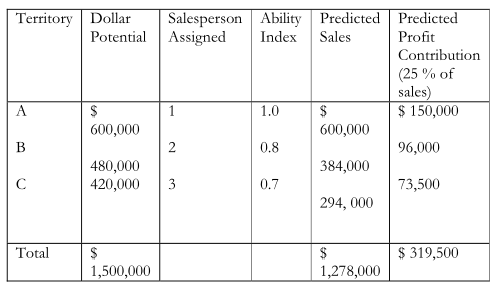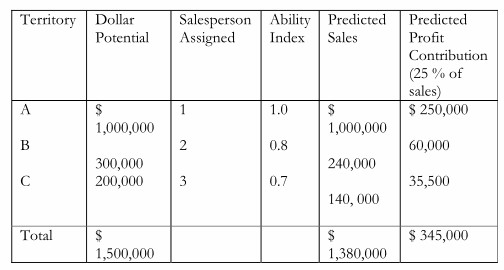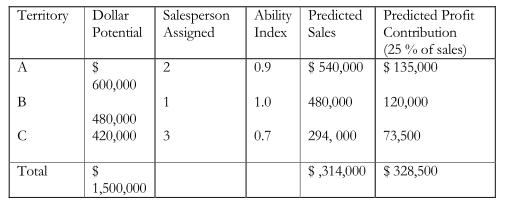When the arrangement is the best obtainable, it is time to assign sales personnel to territories. Up to this point in territorial planning, an implicit assumption has been that all sales personnel are “average,” that is, that all are interchangeable, each capable of producing similar results at similar costs regardless of territorial assignments. Clearly, this is an unrealistic assumption, adopted only for territorial planning purposes, and one that is discarded when sales personnel are assigned to territories. Few sales personnel are average they vary in ability, initiative, and effectiveness as well as in physical condition and energy. What constitutes a reasonable and desirable work load for one individual may not be appropriate for another person. Furthermore, salesperson’s effectiveness varies with the territory assigned. One person is outstanding in one territory and a failure in a second, even though territorial sales potentials and coverage difficulty factors are almost identical. Performance, moreover, is conditioned by customer characteristics, customs and traditions, ethnic influences, and the like. Dyadic interactions, with customers and prospects, in other words, vary in their outcomes from one territory to another depending on many factors, most of them outside the salesperson’s control.
In assigning sales personnel to territories, management seeks the most profitable alignment of selling efforts with sales opportunities. The territories, containing varying sales potentials, represent different amounts of sales opportunity. The sales personnel, differing in ability and potential effectiveness, represent the range of available selling talent. Management should “Assign each sales- person to the particular territory where his or her relative contribution to profit is the highest.” Hauk, “Research in Personal Selling,” pp. 241-42.
The general guide for assigning sales personnel to territories is not universally applicable because the discretion that management has in making these decisions differs from company to company. At one extreme, some companies display great reluctance to transfer sales personnel to different territories, management fearing not only sales force resistance but the consequences of breaking established salesperson-customer relationships. These companies adhere to a “no transfer” or “infrequent transfer” policy and build restrictions on shifting sales personnel into territorial designs. The planner expands or contracts territorial boundaries, adding to or subtracting from individual territorial sales potentials, until territories contain sales potentials appropriate to the abilities of assigned sales personnel. These companies, in effect, design sales territories around, and to fit, the abilities of sales personnel
At the opposite extreme, management in a few companies is free to assign any salesperson to any territory, designing territories (according to procedures like those discussed earlier) and closely aligning salespeople’s ability levels with territorial sales opportunity levels. Management shifts sales personnel to predestined territories where their relative profit contributions are maximized.
The situation in most companies is somewhere between the two extremes. For various reasons, some totally outside management’s control, certain sales personnel are not transfer- able, but others are freely moved from one territory to another. This means that management designs some sales territories to fit the ability levels of nontransferable sales personnel while reassigning other sales personnel with ability levels appropriate to sales territories redesigned according to the suggested procedures.
Illustration of Assigning Sales Personnel to Territories: Now let us work through several situations involving assignment of sales personnel to territories, our purpose being to demonstrate that, where practical, effective sales management assigns each salesperson to the territory where his or her relative profit contribution is maximized.
First, consider the situation in which territories have equal sales potential and coverage difficulty, but the sales personnel differ in ability. Figure 25.1picts this situation. Predicted sales are obtained by multiplying each territory’s dollar potential by the ability index of the salesperson assigned. Predicted profit contributions are assumed to amount to 25 percent of predicted sales. The total profit contribution is $312,500, the maximum attainable here regardless of how the sales personnel are assigned.
Figure 25.1 Assignments of Sales Personnel to Territories of Equal Potential
| Territory | Dollar Potential | Salesperson Assigned | Ability Index | Ability Index | Predicted Profit Contribution (25 % of Sales) |
| A B C | $ 500,000 500,000 500,000 | 1 2 3 | 1.0 0.8 0.7 | $ 500,000 400,000 350, 000 | $ 125,000 100,000 87,500 |
| Total | $1,500,000 | $ 1,250,000 | $ 328,500 |
Now suppose that these territories are redesigned so that their sales potentials vary in direct proportion with the ability of the sales personnel assigned, with the same total dollar potential as before ($1.5 million). The results of this assignment pattern are shown in Figure 25.2Redesigning territories so that sales potentials are directly proportional to abilities of assigned sales personnel increases the predicted profit contribution by $7,000 (from $312,500 to $319,500).
But what is the predicted profit contribution if total sales potential is divided some other way? After all, the number of possible ways of dividing it is very large. Consider Figure 25.3which shows a different division of the $1.5 million sales potential; sales personnel, however, are still assigned territories in rank order of their respective abilities.
Again there is an increase in the predicted profit contribution, this one even more impressive than in the preceding example. However, it is unlikely that this is a feasible territorial division and salespersons assignment plan. The coverage difficulty and associated work load now involved in covering territory A would likely exceed salesperson 1 ‘s capacity to perform; thus, l’s ability index should be lowered. Similarly, territories Band C now have such greatly reduced sales potentials (which means that their coverage difficulty is less than before) that probably neither would represent sufficient workloads for salesperson 2 or 3.
Figure 25.2Assignment of Sales Personnel to Territories Containing Sales Potentials Proportionate to Salespersons’ Ability

FIGURE 25.3 Assignment of Sales Personnel to ability to Territories Containing Different Sales Potentials

There are upper and lower limits to the amount of sales potential to incorporate in anyone territory. These limits are set by coverage difficulty and the size of the work load that it is reasonable to expect any salesperson, regardless of ability, to assume. Then, too, selling expenditures do not fluctuate directly with predicted sales volumes throughout all sales volume ranges. They may rise more or less in proportion to sales volume increases, but after a certain point is reached, the rate of rise accelerates greatly (that is, as the difficulty of making sales becomes increasingly greater), and they may decline proportionately to sales volume decreases until a minimum .level is reached (where potential sales are no longer large enough to support needed selling expenditures). Work load restrictions, in other words, confine the uniformity of variation of selling expenditures within fairly narrow limits.
The optimum territorial arrangement is reached when the incremental sales produced per dollar of selling expenditures are equated among all territories. After a sales territory reaches a certain size in terms of sales potential, adding successive increments of sales potential is feasible only up to the point at which the last dollar of selling expenditures just brings in sufficient sales to provide a dollar of profit contribution. A company seeking the optimum territorial arrangement generally concludes that it is wise to cut off additional selling expenditures before reaching this “point of feasibility.” This is because the best condition requires the equating among all territories of the incremental sales produced by the last dollar of selling expenditures in each.
Thus far, an implicit assumption has been that ability indexes do not change with assignment of sales personnel. However, sales personnel have different degrees of effectiveness in different territories, because environmental forces condition selling performance. It is not realistic, in other words, to assume that ability indexes for individual sales personnel are fixed regardless of the territorial assignment.
Consider, then, a situation where sales personnel maintain their rank order according to ability indexes as they are switched among territories but where the indexes change. With the assignment pattern 1A, 2B, 3C, the respective ability indexes might be 1.0, 0.8, and 0.7 (as in Figure 25.2, for example), but with the assignment I B, 2A, 3C, the respective ability indexes could be 1.0, 0.9, af\d 0.7-salesperson I in this situation performs better than salesperson 2 regard- less of the assignment. Using the basic data in Figure 25.2 the results of the IB-2A-3C assignment are shown in Figure 25.4. This assignment pattern results in a higher total profit contribution than that secured by assigning sales personnel to territories strictly in accord with their abilities (that is, $328,500 versus $319,500).
FIGURE 25.4Assignment of Sales Personnel to Territories where Ability Indexes Vary with the Assignment

Thus in some territorial designs, the best salesperson should not necessarily be assigned to the territory with the highest sales potential, and in some, a salesperson should not necessarily be assigned to the one territory where his or her profit contribution is higher than that of any other salesperson who might be assigned to the same territory. Each salesperson should be assigned to the territory where his or her relative contribution to profit is the highest. In Figure 25.4 salesperson 1 could make a higher dollar profit contribution than salesperson 2 in territory A, but 1 contributes more, relative to 2, when assigned to territory B. Similarly, salesperson 2’s inferiority relative to salesperson 1 is less when 2 has territory A, not territory B.
Ability indexes change with different assignment patterns; consequently, management estimates ability indexes for each possible assignment pattern. The large number of possible assignment patterns makes complex the task of achieving an ideal assignment. When twelve salespeople are to be assigned to twelve territories, for example, there are 12! (That is 479,001,600) possible pat- terns. It would be possible, although not practical, to write down all 479,001,600 assignment. Patterns and select the one providing the maximum profit contribution; fortunately, however, the assignment linear programming technique and the computer afford a rapid and less laborious way to find the solution. But even this technique requires estimates for the probable net profit contribution for each salesperson for each possible assignment pattern, and this requires not only knowledge of the nature and peculiarities of each territory, but insight on how each salesperson might perform in each territorial environment.
‘Strictly speaking, of course, the planner might now reapportion the total sales potential among the three territories in direct proportion to the revised ability indexes of the sales personnel assigned to each, thus obtaining a still further increase in the total profit contribution. The perceptive reader will see that this reapportionment would involve making territory 8 a higher- potential area than territory A. The resulting personnel assignment pattern, then, would be one in which the best salesperson (no. I) would have the territory with the highest sales potential (now territory B), but note care- fully that each salesperson still would be assigned to the territory where his or her relative contribution to profit is the highest
Let us now see how sales personnel can plan their calls in order to save time and increase the market coverage.

